Tomorrow's
JobsMaking informed
career decisions requires reliable information about opportunities in the future.
Opportunities result from the relationships between the population, labor force,
and the demand for goods and services. Population
ultimately limits the size of the labor force—individuals working or looking for
work—which constrains how much can be produced. Demand for various goods and services
determines employment in the industries providing them. Occupational employment
opportunities, in turn, result from demand for skills needed within specific industries.
Opportunities for medical assistants and other healthcare occupations, for example,
have surged in response to rapid growth in demand for health services. Examining
the past and projecting changes in these relationships is the foundation of the
Occupational Outlook Program. This chapter presents highlights of Bureau of Labor
Statistics projections of the labor force and occupational and industry employment
that can help guide your career plans.
Population
trends affect employment opportunities in a number of ways. Changes in population
influence the demand for goods and services. For example, a growing and aging
population has increased the demand for health services. Equally important, population
changes produce corresponding changes in the size and demographic composition
of the labor force. The
U.S. civilian noninstitutional population is expected to increase by 23.9 million
over the 2004-14 period, at a slower rate of growth than during both the 1994-2004
and 1984-94 periods (Chart 1). Continued
growth will mean more consumers of goods and services, spurring demand for workers
in a wide range of occupations and industries. The effects of population growth
on various occupations will differ. The differences are partially accounted for
by the age distribution of the future population. 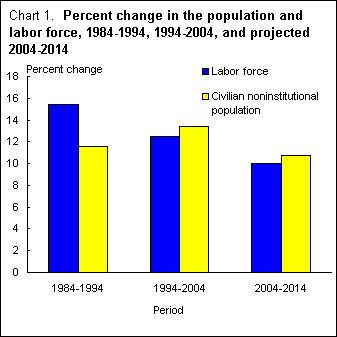 The
youth population, aged 16 to 24, will grow 2.9 percent over the 2004-14 period.
As the baby boomers continue to age, the group aged 55 to 64 will increase by
36 percent or 10.4 million persons, more than any other group. The group aged
35 to 44 will decrease in size, reflecting the birth dearth following the baby
boom generation. Minorities
and immigrants will constitute a larger share of the U.S. population in 2014.
The number of Hispanics is projected to continue to grow much faster than those
of all other racial and ethnic groups.
Population
is the single most important factor in determining the size and composition of
the labor force—that is, people who are either working or looking for work. The
civilian labor force is projected to increase by 14.7 million, or 10 percent,
to 162.1 million over the 2004-14 period. The
U.S. workforce will become more diverse by 2014. White, non-Hispanic persons will
continue to make up a decreasing share of the labor force, falling from 70 percent
in 2004 to 65.6 percent in 2014 (Chart
2). However, despite relatively slow growth, white, non-Hispanics will remain
the largest group in the labor force in 2014. Asians are projected to account
for an increasing share of the labor force by 2014, growing from 4.3 to 5.1 percent.
Hispanics are projected to be the fastest growing of the four labor force groups,
growing by 33.7 percent. By 2014, Hispanics will continue to constitute a larger
proportion of the labor force than will blacks, whose share will grow from 11.3
percent to 12.0 percent. 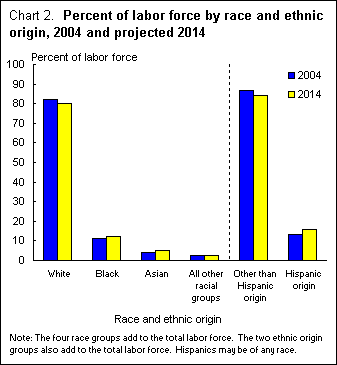 The
numbers of men and women in the labor force will grow, but the number of women
will grow at a faster rate than the number of men. The male labor force is projected
to grow by 9.1 percent from 2004 to 2014, compared with 10.9 percent for women.
As a result, men’s share of the labor force is expected to decrease from 53.6
to 53.2 percent, while women’s share is expected to increase from 46.4 to 46.8
percent. The youth
labor force, aged 16 to 24, is expected to slightly decrease its share of the
labor force to 13.7 percent by 2014. The primary working age group, between 25
and 54 years old, is projected to decline from 69.3 percent of the labor force
in 2004 to 65.2 percent by 2014. Workers 55 and older, on the other hand, are
projected to increase from 15.6 percent to 21.2 percent of the labor force between
2004 and 2014, due to the aging of the baby-boom generation (Chart
3). 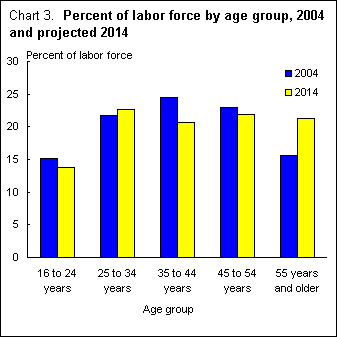
Total employment
is expected to increase from 145.6 million in 2004 to 164.5 million in 2014, or
by 13 percent. The 18.9 million jobs that will be added by 2014 will not be evenly
distributed across major industrial and occupational groups. Changes in consumer
demand, technology, and many other factors will contribute to the continually
changing employment structure in the U.S. economy. The
following two sections examine projected employment change from both industrial
and occupational perspectives. The industrial profile is discussed in terms of
primary wage and salary employment. Primary employment excludes secondary jobs
for those who hold multiple jobs. The exception is employment in agriculture,
which includes self-employed and unpaid family workers in addition to wage and
salary workers. The
occupational profile is viewed in terms of total employment—including primary
and secondary jobs for wage and salary, self-employed, and unpaid family workers.
Of the nearly 146 million jobs in the U.S. economy in 2004, wage and salary workers
accounted for 133.5 million; self-employed workers accounted for 12.1 million;
and unpaid family workers accounted for about 141,000. Secondary employment accounted
for 1.7 million jobs. Self-employed workers held 9 out of 10 secondary jobs; wage
and salary workers held most of the remainder.
Service-providing
industries. The long-term shift from goods-producing to service-providing
employment is expected to continue. Service-providing industries are expected
to account for approximately 18.7 million of the 18.9 million new wage and salary
jobs generated over the 2004-14 period (Chart 4).
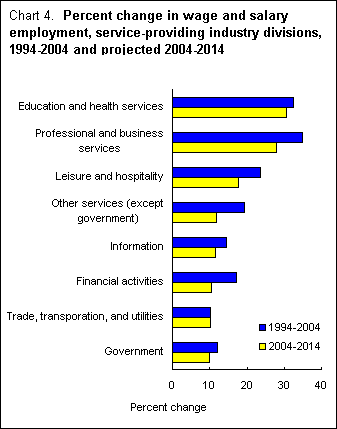 Education
and health services. This industry supersector is projected to grow faster,
30.6 percent, and add more jobs than any other industry supersector. About 3 out
of every 10 new jobs created in the U.S. economy will be in either the healthcare
and social assistance or private educational services sectors. Healthcare
and social assistance—including private hospitals, nursing and residential care
facilities, and individual and family services—will grow by 30.3 percent and add
4.3 million new jobs. Employment growth will be driven by increasing demand for
healthcare and social assistance because of an aging population and longer life
expectancies. Also, as more women enter the labor force, demand for childcare
services is expected to grow. Private educational services will grow by 32.5 percent
and add 898,000 new jobs through 2014. Rising student enrollments at all levels
of education will create demand for educational services. Professional
and business services. This industry supersector, which includes some of
the fastest growing industries in the U.S. economy, will grow by 27.8 percent
and add more than 4.5 million new jobs. Employment
in administrative and support and waste management and remediation services will
grow by 31 percent and add 2.5 million new jobs to the economy by 2014. The fastest
growing industry in this sector will be employment services, which will grow by
45.5 percent and will contribute almost two-thirds of all new jobs in administrative
and support and waste management and remediation services. Employment services
ranks among the fastest growing industries in the Nation and is expected to be
among those that provide the most new jobs. Employment
in professional, scientific, and technical services will grow by 28.4 percent
and add 1.9 million new jobs by 2014. Employment in computer systems design and
related services will grow by 39.5 percent and add almost one-fourth of all new
jobs in professional, scientific, and technical services. Employment growth will
be driven by the increasing reliance of businesses on information technology and
the continuing importance of maintaining system and network security. Management,
scientific, and technical consulting services also will grow very rapidly, by
60.5 percent, spurred by the increased use of new technology and computer software
and the growing complexity of business. Management
of companies and enterprises will grow by 10.6 percent and add 182,000 new jobs. Information.
Employment in the information supersector is expected to increase by 11.6 percent,
adding 364,000 jobs by 2014. Information contains some of the fast-growing computer-related
industries such as software publishers; Internet publishing and broadcasting;
and Internet service providers, Web search portals, and data processing services.
Employment in these industries is expected to grow by 67.6 percent, 43.5 percent,
and 27.8 percent, respectively. The information supersector also includes telecommunications,
broadcasting, and newspaper, periodical, book, and directory publishers. Increased
demand for residential and business land-line and wireless services, cable service,
high-speed Internet connections, and software will fuel job growth among these
industries. Leisure
and hospitality. Overall employment will grow by 17.7 percent. Arts, entertainment,
and recreation will grow by 25 percent and add 460,000 new jobs by 2014. Most
of these new job openings will come from the amusement, gambling, and recreation
sector. Job growth will stem from public participation in arts, entertainment,
and recreation activities—reflecting increasing incomes, leisure time, and awareness
of the health benefits of physical fitness. Accommodation
and food services is expected to grow by 16.5 percent and add 1.8 million new
jobs through 2014. Job growth will be concentrated in food services and drinking
places, reflecting increases in population, dual-income families, and dining sophistication Trade,
transportation, and utilities. Overall employment in this industry supersector
will grow by 10.3 percent between 2004 and 2014. Transportation and warehousing
is expected to increase by 506,000 jobs, or by 11.9 percent through 2014. Truck
transportation will grow by 9.6 percent, adding 129,000 new jobs, while rail transportation
is projected to decline. The warehousing and storage sector is projected to grow
rapidly at 24.8 percent, adding 138,000 jobs. Demand for truck transportation
and warehousing services will expand as many manufacturers concentrate on their
core competencies and contract out their product transportation and storage functions. Employment
in retail trade is expected to increase by 11 percent, from 15 million to 16.7
million. Increases in population, personal income, and leisure time will contribute
to employment growth in this industry, as consumers demand more goods. Wholesale
trade is expected to increase by 8.4 percent, growing from 5.7 million to 6.1
million jobs. Employment
in utilities is projected to decrease by 1.3 percent through 2014. Despite increased
output, employment in electric power generation, transmission, and distribution
and natural gas distribution is expected to decline through 2014 due to improved
technology that increases worker productivity. However, employment in water, sewage,
and other systems is expected to increase 21 percent by 2014. Jobs are not easily
eliminated by technological gains in this industry because water treatment and
waste disposal are very labor-intensive activities. Financial
activities. Employment is projected to grow 10.5 percent over the 2004-14
period. Real estate and rental and leasing is expected to grow by 16,9 percent
and add 353,000 jobs by 2014. Growth will be due, in part, to increased demand
for housing as the population grows. The fastest growing industry in the financial
activities supersector will be activities related to real estate, which will grow
by 32.1 percent, reflecting the housing boom that persists throughout most of
the Nation. Finance
and insurance is expected to increase by 496,000 jobs, or 8.3 percent, by 2014.
Employment in securities, commodity contracts, and other financial investments
and related activities is expected to grow 15.8 percent by 2014, reflecting the
increased number of baby boomers in their peak savings years, the growth of tax-favorable
retirement plans, and the globalization of the securities markets. Employment
in credit intermediation and related services, including banks, will grow by 5.4
percent and add about one-third of all new jobs within finance and insurance.
Insurance carriers and related activities is expected to grow by 9.5 percent and
add 215,000 new jobs by 2014. The number of jobs within agencies, brokerages,
and other insurance related activities is expected to grow about 19.4 percent,
as many insurance carriers downsize their sales staffs and as agents set up their
own businesses. Government.
Between 2004 and 2014, government employment, including that in public education
and hospitals, is expected to increase by 10 percent, from 21.6 million to 23.8
million jobs. Growth in government employment will be fueled by growth in State
and local educational services and the shift of responsibilities from the Federal
Government to the State and local governments. Local government educational services
is projected to increase 10 percent, adding 783,000 jobs. State government educational
services is projected to grow by 19.6 percent, adding 442,000 jobs. Federal Government
employment, including the Postal Service, is expected to increase by only 1.6
percent as the Federal Government continues to contract out many government jobs
to private companies. Other
services (except government). Employment will grow by 14 percent. More
than 1 out of every 4 new jobs in this supersector will be in religious organizations,
which is expected to grow by 11.9 percent. Other automotive repair and maintenance
will be the fastest growing industry at 30.7 percent. Also included among other
services is personal care services, which is expected to increase by 19.5 percent. Goods-producing
industries. Employment in the goods-producing industries has been relatively
stagnant since the early 1980s. Overall, this sector is expected to decline 0.4
percent over the 2004-14 period. Although employment is expected to decline or
increase more slowly than in the service-providing industries, projected growth
among goods-producing industries varies considerably (Chart
5). 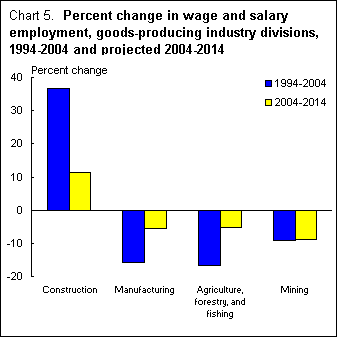 Construction.
Employment in construction is expected to increase by 11.4 percent, from 7 million
to 7.8 million. Demand for new housing and an increase in road, bridge, and tunnel
construction will account for the bulk of job growth in this supersector. Manufacturing.
Employment change in manufacturing will vary by individual industry, but overall
employment in this supersector will decline by 5.4 percent or 777,000 jobs. For
example, employment in transportation equipment manufacturing is expected to grow
by 95,000 jobs. Due to an aging population and increasing life expectancies, pharmaceutical
and medicine manufacturing is expected to grow by 26.1 percent and add 76,000
jobs through 2014. However, productivity gains, job automation, and international
competition will adversely affect employment in many other manufacturing industries.
Employment in textile mills and apparel manufacturing will decline by 119,000
and 170,000 jobs, respectively. Employment in computer and electronic product
manufacturing also will decline by 94,000 jobs through 2014. Agriculture,
forestry, fishing, and hunting. Overall employment in agriculture, forestry,
fishing, and hunting is expected to decrease by 5.2 percent. Employment is expected
to continue to decline due to advancements in technology. The only industry within
this supersector expected to grow is support activities for agriculture and forestry,
which includes farm labor contractors and farm management services. This industry
is expected to grow by 18.2 percent and add 19,000 new jobs. Mining.
Employment in mining is expected to decrease 8.8 percent, or by some 46,000 jobs,
by 2014. Employment in coal mining and metal ore mining is expected to decline
by 23.3 percent and 29.3 percent, respectively. Employment in oil and gas extraction
also is projected to decline by 13.1 percent through 2014. Employment decreases
in these industries are attributable mainly to technology gains that boost worker
productivity, growing international competition, restricted access to Federal
lands, and strict environmental regulations that require cleaning of burning fuels.
Expansion
of service-providing industries is expected to continue, creating demand for many
occupations. However, projected job growth varies among major occupational groups
(Chart 6).
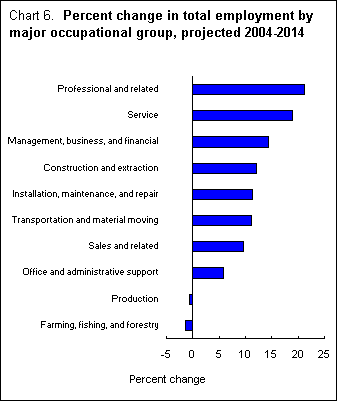 Professional
and related occupations. Professional and related occupations will grow
the fastest and add more new jobs than any other major occupational group. Over
the 2004-14 period, a 21.2-percent increase in the number of professional and
related jobs is projected, which translates into 6 million new jobs. Professional
and related workers perform a wide variety of duties, and are employed throughout
private industry and government. About three-quarters of the job growth will come
from three groups of professional occupations—computer and mathematical occupations,
healthcare practitioners and technical occupations, and education, training, and
library occupations—which will add 4.5 million jobs combined. Service
occupations. Service workers perform services for the public. Employment
in service occupations is projected to increase by 5.3 million, or 19 percent,
the second largest numerical gain and second highest rate of growth among the
major occupational groups. Food preparation and serving related occupations are
expected to add the most jobs among the service occupations, 1.7 million by 2014.
However, healthcare support occupations are expected to grow the fastest, 33.3
percent, adding 1.2 million new jobs. Management,
business, and financial occupations. Workers in management, business, and
financial occupations plan and direct the activities of business, government,
and other organizations. Their employment is expected to increase by 2.2 million,
or 14.4 percent, by 2014. Among managers, the numbers of preschool and childcare
center/program educational administrators and of computer and information systems
managers will grow the fastest, by 27.9 percent and 25.9 percent, respectively.
General and operations managers will add the most new jobs, 308,000, by 2014.
Farmers and ranchers are the only workers in this major occupational group whose
numbers are expected to decline, losing 155,000 jobs. Among business and financial
occupations, accountants and auditors and management analysts will add the most
jobs, 386,000 combined. Employment, recruitment, and placement specialists and
personal financial advisors will be the fastest growing occupations in this group,
with job increases of 30.5 percent and 25.9 percent, respectively. Construction
and extraction occupations. Construction and extraction workers construct
new residential and commercial buildings, and also work in mines, quarries, and
oil and gas fields. Employment of these workers is expected to grow 12 percent,
adding 931,000 new jobs. Construction trades and related workers will account
for more than three-fourths of these new jobs, 699,000, by 2014. Many extraction
occupations will decline, reflecting overall employment losses in the mining and
oil and gas extraction industries. Installation,
maintenance, and repair occupations. Workers in installation, maintenance,
and repair occupations install new equipment and maintain and repair older equipment.
These occupations will add 657,000 jobs by 2014, growing by 11.4 percent. Automotive
service technicians and mechanics and general maintenance and repair workers will
account for half of all new installation, maintenance, and repair jobs. The fastest
growth rate will be among security and fire alarm systems installers, an occupation
that is expected to grow 21.7 percent over the 2004-14 period. Transportation
and material moving occupations. Transportation and material moving workers
transport people and materials by land, sea, or air. The number of these workers
should grow 11.1 percent, accounting for 1.1 million additional jobs by 2014.
Among transportation occupations, motor vehicle operators will add the most jobs,
629,000. Material moving occupations will grow 8.3 percent and will add 405,000
jobs. Rail transportation occupations are the only group in which employment is
projected to decline, by 1.1 percent, through 2014. Sales
and related occupations. Sales and related workers transfer goods and services
among businesses and consumers. Sales and related occupations are expected to
add 1.5 million new jobs by 2014, growing by 9.6 percent. The majority of these
jobs will be among retail salespersons and cashiers, occupations that will add
849,000 jobs combined. Office
and administrative support occupations. Office and administrative support
workers perform the day-to-day activities of the office, such as preparing and
filing documents, dealing with the public, and distributing information. Employment
in these occupations is expected to grow by 5.8 percent, adding 1.4 million new
jobs by 2014. Customer service representatives will add the most new jobs, 471,000.
Desktop publishers will be among the fastest growing occupations in this group,
increasing by 23.2 percent over the decade. However, due to rising productivity
and increased automation, office and administrative support occupations also account
for 11 of the 20 occupations with the largest employment declines. Farming,
fishing, and forestry occupations. Farming, fishing, and forestry workers
cultivate plants, breed and raise livestock, and catch animals. These occupations
will decline 1.3 percent and lose 13,000 jobs by 2014. Agricultural workers, including
farmworkers and laborers, accounted for the overwhelming majority of new jobs
in this group. The number of fishing and hunting workers is expected to decline,
by 16.6, percent, while the number of logging workers is expected to increase
by less than 1 percent. Production
occupations. Production workers are employed mainly in manufacturing, where
they assemble goods and operate plants. Production occupations are expected to
decline less than 1 percent, losing 79,000 jobs by 2014. Jobs will be created
for many production occupations, including food processing workers, machinists,
and welders, cutters, solderers, and brazers. Textile, apparel, and furnishings
occupations, as well as assemblers and fabricators, will account for much of the
job losses among production occupations. Among
all occupations in the economy, computer and healthcare occupations are expected
to grow the fastest over the projection period (Chart
7). ). In fact, healthcare occupations make up 12 of the 20 fastest growing
occupations, while computer occupations account for 5 out of the 20 fastest growing
occupations in the economy. In addition to high growth rates, these 17 computer
and healthcare occupations combined will add more than 1.8 million new jobs. High
growth rates among computer and healthcare occupations reflect projected rapid
growth in the computer and data processing and health services industries.
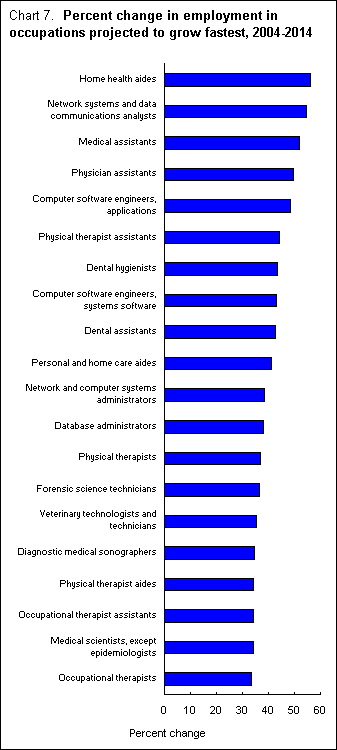 The
20 occupations listed in Chart 8 , 7.1 million
combined, over the 2004-14 period. The occupations with the largest numerical
increases cover a wider range of occupational categories than do those occupations
with the fastest growth rates. Health occupations will account for some of these
increases in employment, as well as occupations in education, sales, transportation,
office and administrative support, and food service. Many of these occupations
are very large, and will create more new jobs than will those with high growth
rates. Only 3 out of the 20 fastest growing occupations—home health aides, personal
and home care aides, and computer software application engineers—also are projected
to be among the 20 occupations with the largest numerical increases in employment.
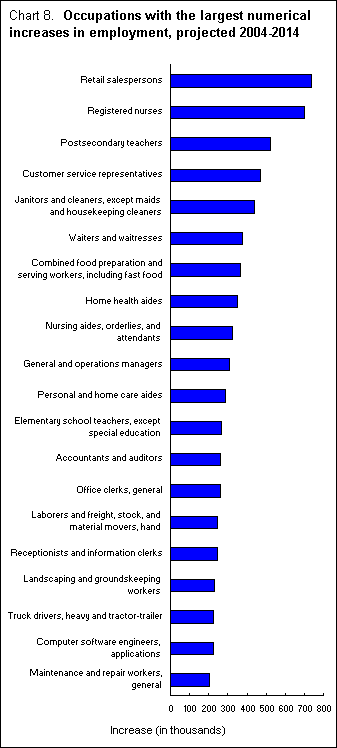 Declining
occupational employment stems from declining industry employment, technological
advancements, changes in business practices, and other factors. For example, increased
productivity and farm consolidations are expected to result in a decline of 155,000
farmers and ranchers over the 2004-14 period (Chart 9). The
majority of the 20 occupations with the largest numerical decreases are office
and administrative support and production occupations, which are affected by increasing
plant and factory automation and the implementation of office technology that
reduces the needs for these workers. For example, employment of word processors
and typists is expected to decline due to the proliferation of personal computers,
which allows other workers to perform duties formerly assigned to word processors
and typists. 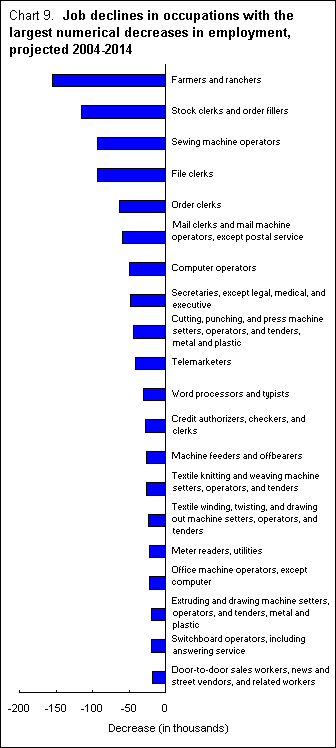
Among the
20 fastest growing occupations, a bachelor’s or associate degree is the most significant
source of postsecondary education or training for 12 of them—network systems and
data communications analysts; physician assistants; computer software engineers,
applications; physical therapist assistants; dental hygienists; computer software
engineers, systems software; network and computer systems administrators; database
administrators; forensic science technicians; veterinary technologists and technicians;
diagnostic medical sonographers; and occupational therapists assistants. On-the-job
training is the most significant source of postsecondary education or training
for another 5 of the 20 fastest growing occupations—physical therapist aides,
medical assistants, home health aides, dental assistants, and personal and home
care aides. In contrast, on-the-job training is the most significant source of
postsecondary education or training for 13 of the 20 occupations with the largest
numerical increases; 6 of these 20 occupations have an associate or higher degree
as the most significant source of postsecondary education or training. On-the-job
training also is the most significant source of postsecondary education or training
for all 20 of the occupations with the largest numerical decreases. Table 1 lists the fastest
growing occupations and occupations projected to have the largest numerical increases
in employment between 2004 and 2014, by level of postsecondary education or training. Job openings
stem from both employment growth and replacement needs (Chart
10). Replacement needs arise as workers leave occupations. Some transfer to
other occupations while others retire, return to school, or quit to assume household
responsibilities. Replacement needs are projected to account for more than 60
percent of the approximately 55 million job openings between 2004 and 2014. Thus,
even occupations projected to experience slower than average growth or to decline
in employment still may offer many job openings. 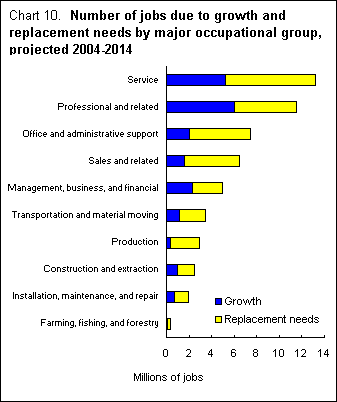 Professional
and related occupations are projected to grow faster and add more jobs than any
other major occupational group, with 6 million new jobs by 2014. Three-fourths
of the job growth in professional and related occupations is expected among computer
and mathematical occupations; healthcare practitioners and technical occupations;
and education, training, and library occupations. With 5.5 million job openings
due to replacement needs, professional and related occupations are the only major
group projected to generate more openings from job growth than from replacement
needs. Service
occupations are projected to have the largest number of total job openings, 13.2
million, reflecting high replacement needs. A large number of replacements will
be necessary as young workers leave food preparation and service occupations.
Replacement needs generally are greatest in the largest occupations and in those
with relatively low pay or limited training requirements. Office
automation will significantly affect many individual office and administrative
support occupations. Overall, these occupations are projected to grow more slowly
than average, while some are projected to decline. Office and administrative support
occupations are projected to create 7.5 million job openings over the 2004-14
period, ranking third behind service and professional and related occupations. Farming,
fishing, and forestry occupations are projected to have the fewest job openings,
approximately 286,000. Because job growth is expected to be slow, and levels of
retirement and job turnover high, more than 95 percent of these projected job
openings are due to replacement needs.
Source: Occupational
Outlook Handbook -- U.S. Department of Labor Bureau of Labor Statistics Selected
Resources:
|

